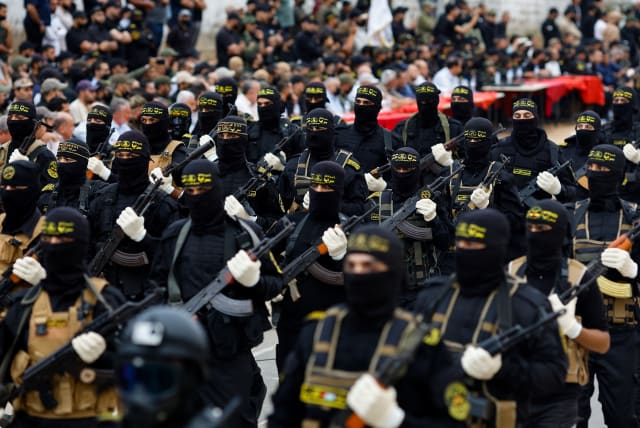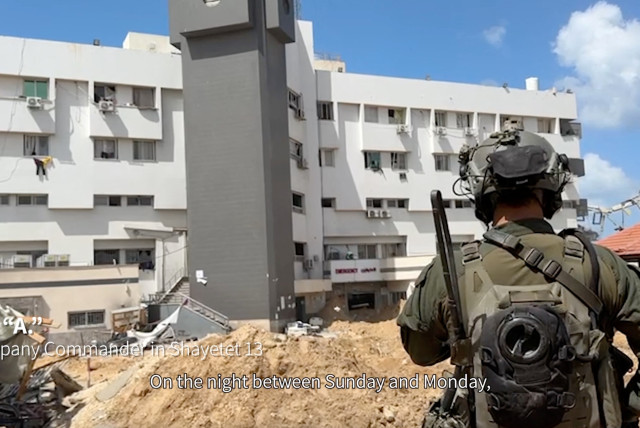How did the IDF let 500 Hamas terrorists return to Shifa Hospital? - analysis

Hamas has largely expected a ceasefire and withdrawal of IDF soldiers to allow its members to return to pockets across northern and central Gaza, including Shifa hospital.
Over the last week, the Israel Defense Forces have been carrying out a complex raid at Shifa Hospital. The hospital is a large, sprawling compound. The raid began a week ago, on the evening of March 17. For seven days, the IDF has been combing buildings and the area, clashing with terrorist gunmen, and detaining suspects. Reports say around 800 suspects were found, and 500 of them are confirmed members of Hamas and Palestinian Islamic Jihad. This is the largest number of terrorists found in one spot since the war began and one of the IDF’s most important and complex operations of this type since October 7.
All of this requires a larger spotlight. How is it possible that so many terrorists, mostly men in their 20s to 50s, all came to this hospital over the last months? They had to have come in the last few months because the IDF first operated to clear the area around Shifa of terrorists in November. This means that these men infiltrated again. These are men with records, some of them involved in terrorism going back many years, including plots in the West Bank linked to the 2014 war as well as the October 7 attacks.
The IDF has emphasized that it found numerous Hamas commanders and a large swath of the PIJ command at Shifa. “At the beginning of the war, we destroyed the underground infrastructure dug under the hospital, and we confiscated military equipment and weapons hidden in it. The terrorists’ command center at Shifa Hospital was dealt with then. The terrorists fled in the previous operation when we called to evacuate the compound,” IDF spokesperson Rear Admiral Daniel Hagari said on March 21.
He also noted that the IDF operated differently to catch Hamas by surprise this time. “We raided the compound by surprise. The operation was led by the 162nd Division and carried out by special forces units led by Shayetet 13, in full cooperation on the ground, shoulder to shoulder with the ISA and Unit 504 for intelligence extraction in the field. We used deception tactics in this operation, and it was this that led to the success and apprehension of all 358 terrorists, and there are more still inside this compound who haven’t managed to escape. This led to Hamas and the Islamic Jihad being severely damaged as a result of the operation,” Hagari said.
We know that after the raid began, the terrorists retreated to key areas of the hospital and holed up in the emergency room, the maternity ward, and the Shifa burn ward. This fits the usual modus operandi of Hamas. They see hospitals as key assets and nodes in their command and control of Gaza. They believe the IDF would not want to work in a hospital and end up with the place being destroyed. The IDF has said now, on March 24, that Hamas has caused damage to many areas of the hospital.
Hamas clearly felt safe at the hospital. They knew that Israel had raided this area in November. For instance, in November, the IDF exposed a tunnel system under the Qatari building at the hospital. The IDF had to go back into the Qatari building again during the raid over the last year. The fact that Hamas felt secure in this area may relate to another recent raid by the IDF targeting the Hamad Towers near Khan Yunis. This project, funded by Doha, was supposed to provide nice suburban apartments for Gazans. Hamas appears to have infiltrated the towers over the last few months. In both cases, Hamas appears to have felt that they were safe at Shifa and at the Hamad towers. Now, they have lost almost 1,000 terrorists in both places when you add up all the people detained in the two operations over the last few weeks.
What does Hamas take into account?
IT’S IMPORTANT to look at the timing here to understand the likely Hamas calculations. In early March, reports indicated that Israel would be pressured into a ceasefire before Ramadan. That meant that the ceasefire was supposed to start around March 10. However, Hamas increased its demands and refused to provide a list of living hostages. Hamas believed that Israel would be pressured into a ceasefire without hostages being released. Israel did reduce operations in Gaza and redeploy some units, but the IDF also stepped up raids in Gaza. This included raids over the last few months in areas the IDF cleared back in November, among them a raid into Shati and then into Zaytun. However, the IDF also warned those in Zaytun about the raid before it happened.
Hamas assumed they would get a warning if the IDF was returning to Shifa. They also assumed that the IDF was facing pressure after having raided Nasser Hospital in Khan Yunis. Hamas figured Israel wouldn’t go back to Shifa, and therefore, almost 1,000 terrorists appear to have congregated there. These large numbers of men congregating together would have been clearly visible. They would have seemed well fed, unlike the tens of thousands of others sheltering near the hospital. In some cases, these men would have been armed. They didn’t need to be armed all the time because arms were stored in various places. Hamas operates like a mafia, and mafia members don’t always need to be armed. The weapons are stored in easy-to-reach locations so members can get to them if necessary. Still, Hamas would have felt secure at Shifa, like returning to their homes, so they didn’t need weapons. They assumed the ceasefire would let them set up a command center there to resume control of northern Gaza, where an estimated 30,000 people are located.
Hamas appears to sometimes operate in Gaza in plain clothes and without weapons, except when it needs weapons. For instance, Hamas gunmen have been involved in killing civilians who were trying to access aid. It appears Hamas is responsible for some of the incidents at the Kuwaiti roundabout near Gaza City. This means that Hamas arms its men when it needs to but often, the men seem to mill around without weapons. When the IDF raided Shifa, at least 180 terrorists were eliminated in gunfights. The terrorists also have mortars nearby.
The overall picture that emerges is that Hamas returned to Shifa because it believed a ceasefire would be announced in early March. When the ceasefire didn’t happen, it likely consulted with its leadership, which is based in Gaza and abroad. It likely heard from them that the West was pushing for the ceasefire and that Hamas should not worry too much; they would soon be reconstituted in northern Gaza.
The surprise raid upset their plans. However, Hamas is still operating in the north and also in central Gaza and the south. For instance, it fired rockets at Ashdod on Monday from Deir al-Balah in central Gaza, the first rocket fire of this kind in two months.
Hamas understands the timeline in Gaza. It can read Western media and watch debates at the UN and the news. It is waiting for a ceasefire. It knows it is hosted abroad by two Western allies and assumes that its hosts and patrons will help return the terror group to power in Gaza and help it come to power in the West Bank. For Hamas, places like Shifa are the natural nodes in their empire of terror in Gaza that they need to reconstitute to take power again.
Jerusalem Post Store
`; document.getElementById("linkPremium").innerHTML = cont; var divWithLink = document.getElementById("premium-link"); if (divWithLink !== null && divWithLink !== 'undefined') { divWithLink.style.border = "solid 1px #cb0f3e"; divWithLink.style.textAlign = "center"; divWithLink.style.marginBottom = "15px"; divWithLink.style.marginTop = "15px"; divWithLink.style.width = "100%"; divWithLink.style.backgroundColor = "#122952"; divWithLink.style.color = "#ffffff"; divWithLink.style.lineHeight = "1.5"; } } (function (v, i) { });

